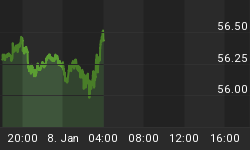We have been reading that virtually every sentiment indicator for the U.S. economy and its stock market is showing optimism far in excess of what happened in early 2000, at the height of the stock market bubble. This euphoria, by the way, is unique to the United States.
Apparently, it was the burst in U.S. real GDP growth during the third quarter of 2003, hitting an annual rate of 8.2%, that has played a key role in kindling the new growth euphoria. Coming from growth rates of 1.4% in the first quarter and 3.3% in the second quarter, all annualized, for many this was the definite breakthrough toward sustained higher economic growth. A forecast of 4-4.5% of real GDP growth in 2004 quickly became the consensus.
It is our long-held opinion that the American practice to annualize many figures confuses many people in the markets. Looking first of all for the true momentum in the economy and also for international comparability, we principally focus on the flat figures stripped of the customary annualization. Outside the United States, that is the general practice. For us, therefore, America's growth performance from quarter to quarter during 2003 reads as follows: 0.35%, 0.8% and 2.05%.
There was an economic upturn, for sure, but a very weak one in comparison to the postwar cyclical norm. That is, in our view, the first important fact to note. Far more important, though, is a second, also grossly neglected question. It concerns the staying power and the dynamics inherent to the current U.S. economic upturn.
In principle, economic growth can have two flagrantly different sources: first, sound fundamentals making for self-sustaining and self-accelerating economic growth; and second, artificial monetary and fiscal stimulus. But since both cutting interest rates and running budget deficits have their limits, success or failure of such stimuli essentially depends on their ability to trigger a recovery that quickly develops strong momentum of its own.
In the 1930s, they had a specific expression in this respect - to prime the pump. It was borrowed from life on the farm. When a pump failed to work, it was customary to pour water into its bulk and ferociously jolt the handle until the water came again. But it was very well known that this only worked when the pump was in good order.
This is, indeed, the key question about the U.S. economy. Has the huge combined monetary and fiscal stimulus injected into it over the last three years achieved sufficient traction to unleash a solid, self-sustaining and self-accelerating recovery? To quote economic theorist Joseph A. Schumpeter: "Our analysis leads us to believe that recovery is sound only if it does come from itself. For any revival which is merely due to artificial stimulus leaves part of the work of depression undone and adds, to an undigested remnant of maladjustments, new maladjustments of its own."
In this respect, the sluggish recovery of the past few years clearly has nothing in common with past postwar cyclical recoveries. In their cases, the economy promptly jump-started when the Fed eased. Actually, the same was true around the world. This time, the most aggressive monetary and fiscal pump priming of all time, now in its fourth year, is showing just mediocre economic effects. The familiar self-accelerating recovery remains elusive.
For us, this flagrant divergence in policy traction has a distinct reason. The monetary easing in the wake of past recessions had an entirely different character than that of the last few years.
Past recessions had their decisive cause in monetary tightening by central banks, putting a brake on borrowing and lending. In turn, the monetary easing ending past recessions meant in essence that the central banks loosened their brakes on money and credit growth that they had pulled earlier to slow the economy. Freed of these shackles, the basically sound economies promptly took off with a vengeance.
But this regular prompt and strong upward response of the economies to monetary easing had still another main cause that is completely missing this time. Because of the imposed credit restraint, a large cushion of pent-up demand used to accumulate during recessions. Once the credit restraint fell away, this store of suppressed demand erupted. The existence of such pent-up demand was plainly a key condition for the regular, prompt post-recession recoveries.
Assessing the present economic situation, it has to be realized that the Fed's persistent, unusually aggressive monetary ease was not prone to create pent-up demand. Implicitly, it had the exact opposite effect. Lured by extremely cheap and easy money, the consumer stampeded into an unprecedented borrowing binge to sustain even higher spending. While income growth from wages and salaries has literally collapsed since 2000, his spending is actually up 10% in real terms.
Following past recessions, as soon as the Fed eased, "pent-up" demand shot up almost immediately. But this time, with savings at a record low and consumer spending at a record high, the consumer already seems to have his regular post-recession spending binge behind him, rather than before him. This does not bode well for those who consider the U.S. to be on the road to self-sustaining and self-accelerating growth.
Regards,
















